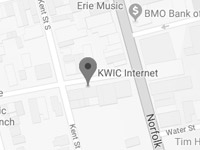These days, the choices for home or business internet are a dime a dozen. At KWIC Internet, we believe in empowering users with more choice at more affordable prices, and with no compromises! That’s why we’re excited to offer a wide array of DSL and cable internet plans to suit as many usage styles as possible.
With that said, just what are the differences between DSL and cable internet, and do they really matter? As it turns out, there are a number of deciding factors to consider. Let’s explore in more detail together.
What is DSL?
DSL stands for digital subscriber line. This form of internet is by far the most common and widely adopted; most of us have a connection installed via one of those old landline boxes on the wall in our homes or businesses. New lines can also be set up if you don’t have this. Unlike dialup, the technologies used in DSL connections allow for frequencies unique from those of dedicated phone lines – in other words, you won’t have to hang up to go online or vice-versa!
DSL comes in two varieties: asymmetrical and symmetrical. The latter provides a balance of upload and download speed bandwidths, while the former gives you much faster download speeds. In the age of streaming, remote working and online gaming, asymmetrical DSL connections are much more popular. Plus, DSL, in general, is so commonplace that prices are the lowest they’ve ever been with certain providers including KWIC Internet – speaking of which, we offer a wide number of plan configurations to suit everything from Wi-Fi preferences to your need for specific speeds, all without overpaying for features or bandwidth that you wouldn’t normally use!
What is Cable Internet?
Ever hear of gigabit internet connections? These are high-powered that can give you blazing-fast download speeds. Cable internet is designed to take advantage of this and the many latest advancements in home and business internet. Usually consisting of a copper coaxial cable – the same as a traditional cable TV connection – it provides even more performance than DSL. The trick here is, to get the best possible upload and download speeds, the modem is usually LAN-only, which means it doesn’t have a dedicated Wi-Fi router. You may need to purchase a router separately if you need wireless connectivity, though there are some devices out there that act as both. The great thing about cable internet is that it’s readily available wherever cable TV connections can be installed. And, if that’s not enough, there are even fibre-optic cable internet connections that provide even more performance – say goodbye to buffering videos and spotty Zoom calls!
So, DSL vs Cable Internet: What to Choose?
Remember how we mentioned there are various factors to consider when choosing a home or business internet plan? Well, here are the main considerations to bear in mind:
- Do you need to support a large number of active users without slowdowns?
- Do you download a lot of content? If so, how much, and are you satisfied with the speeds?
- 4K video streaming and videoconferencing typically require more bandwidth. Do you use such services?
- If you upload (share) a lot of content online, do you find it takes too long to do so with your current connection? If so, consider opting for a service with better upload speeds.
Examples of Ideal Use Cases
If you have a large household that spends a lot of time online for various reasons – streaming, gaming, social media and the like – a higher-tier DSL or standard cable internet plan may work best for you. The more users you have on the same network, the harder your modem and router need to work to push the signal to their devices. This also means that the more devices you have on your network, the more strained your connection will be if you don’t opt for a plan with more bandwidth. We would also recommend an unlimited usage plan to ensure your bill always stays the same with no unwanted surprises. All of these considerations can apply to business users as well if you manage a large onsite team.
Alternatively, if you’re a small household or a business with only a few employees – and if you’re not a power user and simply need a stable connection for research and productivity – most DSL plans would provide the best value to performance ratio. After all, you don’t need to pay for lightning-fast speeds and bandwidth that you won’t fully utilize!
Getting the most out of your internet – and at a great price – has never been easier or more convenient thanks to the sheer number of options available. To learn about our cable and DSL internet packages, contact us at KWIC Internet today – we’re happy to help, and you can count on us for world-class support whenever it’s needed!
